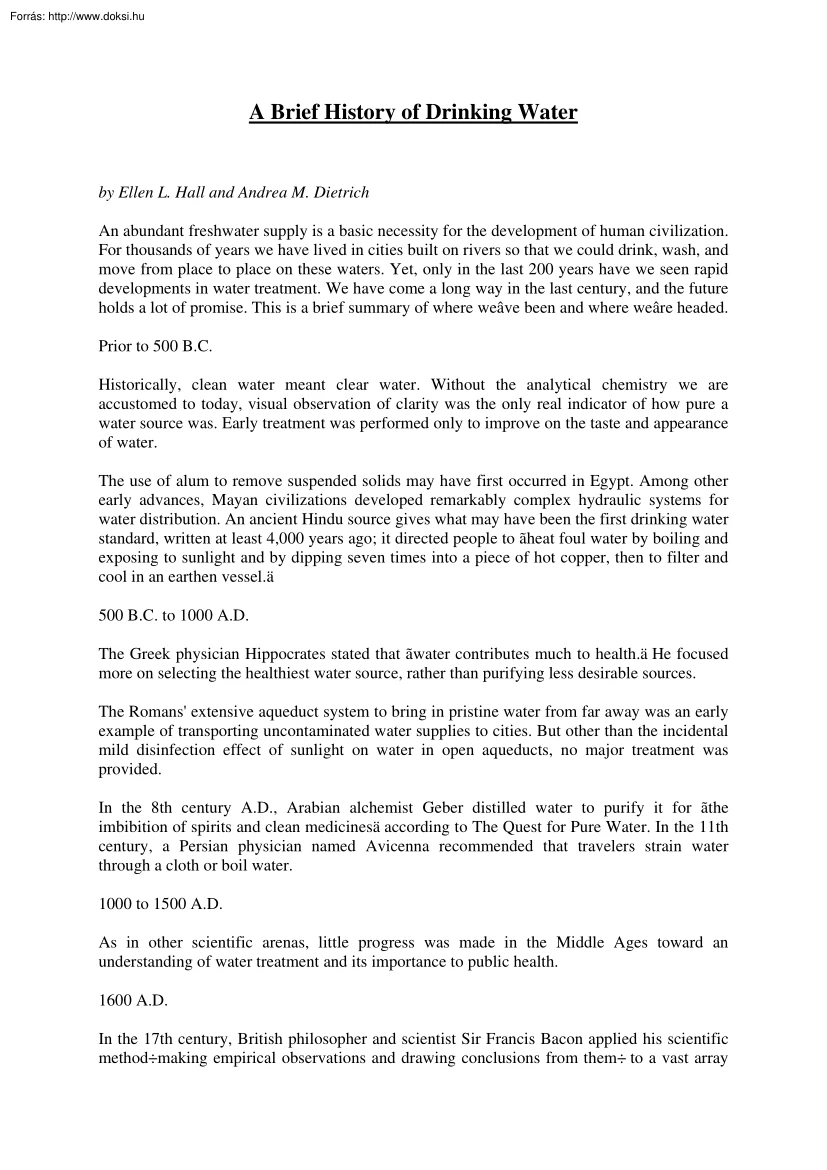Értékelések
Nincs még értékelés. Legyél Te az első!
Tartalmi kivonat
A Brief History of Drinking Water by Ellen L. Hall and Andrea M Dietrich An abundant freshwater supply is a basic necessity for the development of human civilization. For thousands of years we have lived in cities built on rivers so that we could drink, wash, and move from place to place on these waters. Yet, only in the last 200 years have we seen rapid developments in water treatment. We have come a long way in the last century, and the future holds a lot of promise. This is a brief summary of where weâve been and where weâre headed Prior to 500 B.C Historically, clean water meant clear water. Without the analytical chemistry we are accustomed to today, visual observation of clarity was the only real indicator of how pure a water source was. Early treatment was performed only to improve on the taste and appearance of water. The use of alum to remove suspended solids may have first occurred in Egypt. Among other early advances, Mayan civilizations developed remarkably complex
hydraulic systems for water distribution. An ancient Hindu source gives what may have been the first drinking water standard, written at least 4,000 years ago; it directed people to ãheat foul water by boiling and exposing to sunlight and by dipping seven times into a piece of hot copper, then to filter and cool in an earthen vessel.ä 500 B.C to 1000 AD The Greek physician Hippocrates stated that ãwater contributes much to health.ä He focused more on selecting the healthiest water source, rather than purifying less desirable sources. The Romans' extensive aqueduct system to bring in pristine water from far away was an early example of transporting uncontaminated water supplies to cities. But other than the incidental mild disinfection effect of sunlight on water in open aqueducts, no major treatment was provided. In the 8th century A.D, Arabian alchemist Geber distilled water to purify it for ãthe imbibition of spirits and clean medicinesä according to The Quest for Pure
Water. In the 11th century, a Persian physician named Avicenna recommended that travelers strain water through a cloth or boil water. 1000 to 1500 A.D As in other scientific arenas, little progress was made in the Middle Ages toward an understanding of water treatment and its importance to public health. 1600 A.D In the 17th century, British philosopher and scientist Sir Francis Bacon applied his scientific method÷making empirical observations and drawing conclusions from them÷ to a vast array of subjects, including water. In 1627 he published thousands of experiments detailing water purification methods, including percolation, filtration, boiling, distillation, and coagulation. In 1684, Dutch naturalist Antony van Leeuwenhoek published sketches of his ãwee animalcules,ä common forms of bacteria viewed with a simple microscope that he made himself. 1700 A.D Moving into the Age of Enlightenment in the 18th century, natural philosophy (what we now term science) began to be viewed
as something that could have practical value to humans. In 1703, Parisian scientist Phillippe La Hire presented a plan to provide a sand filter and rainwater cistern in every individual household. He also documented that groundwater was rarely contaminated. In 1746, fellow Frenchman Joseph Amy was granted the first patent for a filter design. The filters consisted primarily of sponges and sand in a variety of configurations, the smallest of which provided for the passage of water through sponges in a perforated plate. Later in the century, filtered water was sold on a small scale, but no large commercial plants were built. James Peacock, a British architect, was granted a patent in 1791 on a three-tank, upward-flow backwash filter. 1800 A.D In 1804, Paisley, Scotland, became the site of the first filter facility to deliver water to an entire town. In 1806, a large water treatment plant opened in Paris, using the River Seine as a source. Water was settled for 12 hours prior to
filtration then run through sponge prefilters that were renewed every hour. The main filters consisted of coarse river sand, clean sand, pounded charcoal, and clean Fountainebleau sand. The filters were renewed every six hours A simple form of aeration was also part of the process, and pumps were driven by horses working in three shifts (steam power was too expensive). This plant operated for 50 years A year later in Glasgow, Scotland, filtered water was piped directly to customers. The year 1832 saw the first slow sand filtration plant in the United States built in Richmond, Va. In 1833, the plant had 295 water subscribers The next US plant to open was in Elizabeth, N.J, in 1855 A typhoid epidemic in 1850s London was associated with bad water, but the actual cause of the disease was unknown. British physician Sir John Snow traced the 1854ö55 cholera outbreak in London to sewage contamination of a particular public well. His discovery became known as the Broad Street Pump Affair. Up
until the late 1860s, only 136 waterworks operated in the US. Many of these delivered what was considered to be pure water that did not require filtration. Following the Civil War, waterworks construction increased significantly. Slow sand filters were introduced in Massachusetts in the mid-1870s. Sand filters and other treatments were primarily designed to improve the aesthetic quality of water. It took major developments in bacteriology during the 1870s and 1880s to demonstrate that microorganisms that exist in water supplies can cause human and animal diseases. This led to the realization that water treatment could help prevent disease. Robert Koch, the German physician and microbiologist who postulated the ãgerm theory of disease,ä and the Scottish surgeon Joseph Lister were major players in this work. In 1881, William Stripe, superintendent of waterworks at Keokuk, Iowa, issued an invitation to all persons concerned with waterworks design, construction, operation,
maintenance, and management to gather at Washington University in St. Louis, Mo The 22 respondents to this call to exchange ãinformation pertaining to the management of water works, mutual advancement of consumers and water companies, and to secure economy and uniformity in the operation of water companies,ä together founded the American Water Works Association. By the 1890s filtration was gaining recognition for not only straining out undesirable particles, but also removing deadly germs. Towns and cities along the Hudson River in New York State that used filtration for water purification had fewer outbreaks and incidences of typhoid than communities that did not filter the Hudson River water. In the mid 1890s, the Louisville (Ky.) Water Co combined coagulation with rapid sand filtration, reducing both turbidity and bacteria in the water. Significant improvements to water treatment in the 1880s and 1890s included development of rapid sand filters, which were mechanically driven and
could handle larger volumes, improved operation of slow sand filters, and the first applications of chlorine and ozone for disinfection. At an 1894 meeting of the American Public Health Association, waterworks engineer George Warren Fuller suggested that a cooperative effort toward standardization of bacteriological testing was needed so that results from different laboratories could be compared. The result was an 1897 report that evolved into the Standard Methods text used today. 1900 A.D The year 1906 saw the installation of slow sand filters in Philadelphia and the use of ozone as a disinfectant in Nice, France. In the early 1900s, ozonation for disinfection became common in Europe, but was less prevalent in the US. Ozonation equipment was more complex and costly than that used for chlorination, but ozone caused fewer taste and odor problems. Many Europeans also were reluctant to use chlorine after World War I because it had been used as a chemical warfare agent. In 1908, Jersey
City (N.J) Water Works became the first utility in the US to use sodium hypochlorite for primary disinfection, and the Bubbly Creek plant in Chicago instituted regular chlorine disinfection (electrolytic generation of chlorine and hypochlorites was by then a readily available technology). In that same year information became available on bacterial kill rates, which led to the Chick and Watson model of chemical inactivation of microorganisms. Numbers of typhoid cases often plummeted following introduction of chlorine. In 1914, the US Department of Treasury promulgated the countryâs first drinking water bacteriological standard, a maximum level of 2 coliforms per 100 mL. This only applied to interstate systems, as the authority to establish such a regulation was created under the 1893 Interstate Quarantine Act, intended to prevent the spread of disease from one state or possession to another. Chloramination was first used in 1917 in Ottawa, Ont., and Denver, Colo Initially, chlorine
was applied for disinfection on a dosage basis. In 1919, Americans Abel Wolman and LH Enslow demonstrated that chlorine consumption varied dramatically depending on the characteristics of the water and developed the concept of chlorine demand as the amount added minus the residual present after a specified time period. By the 1920s and 1930s, use of filtration and chlorination had virtually eliminated epidemics of major waterborne diseases such as typhoid and cholera from the American landscape. In 1925, the US bacteriological standard was revised to 1 coliform per 100 mL, and standards for lead, copper, zinc, and excessive soluble mineral substances were added. These two decades also saw the development of dissolved air flotation (patented 1924), early membrane filters (primarily for analytical use), floc-blanket sedimentation, and the solids-contact clarifier. A major step in the development of desalination technologies came in the 1940s during World War II when various military
establishments in arid areas needed water to supply their troops. In 1942, the US Public Health Service adopted a set of drinking water standards that included bacteriological sampling in the distribution system and maximum permissible concentrations for lead, fluoride, arsenic, and selenium. Hexavalent chromium was added to this list in 1946, and the membrane filter process for bacteriological analysis was approved in 1957. By the early 1960s, more than 19,000 municipal water systems were in operation throughout the US. Most of these facilities used chlorine for disinfection Although ozone was in common use in continental Europe throughout the 20th century, by 1987 only five US water treatment facilities were using it, primarily for taste-and-odor control or trihalomethane precursor removal. With the exception of the coliform standard in interstate commerce, US drinking water standards were nonenforceable guidelines until the Safe Drinking Water Act of 1974. The SDWA came about in
large part because of concerns about organic contaminants, and the law laid out the process that the US Environmental Protection Agency would use to set healthbased maximum contaminant levels (MCLs) and the aesthetic-related secondary MCLs. Although the focus of USEPA regulations in the 1980s was on minimization of disinfection by-products, concern for both chemical and microbial contaminants dominated the water industry in the 1990s. The 1993 Cryptosporidium outbreak in Milwaukee, Wis, served as a reminder that another pathogen always exists that may cause acute health effects if a breakdown in treatment occurs. The 1996 amendments to the SDWA were a step in the direction of stronger cooperation between utilities and USEPA in establishing new regulations. 2000 and Beyond Today, the processes of filtration and disinfection are still in use, but are continually being refined based on our better understanding of the complex web of physical and chemical interactions that make these
processes work. Particles can now be measured in microns, and we can detect compounds to part-per-billion and part-per-trillion levels. Regulations now require not only proper disinfection but also careful control of disinfection by-products. Membranes are starting to provide the same functions as conventional treatment and alternative disinfection methods such as ultraviolet light are coming into focus. In addition to water treatment practices, water systems must work toward solutions to the formidable problems of source water protection and water scarcity, as well as how to replace an aging infrastructure. Changes in how much we charge for water will become increasingly important as water becomes an even more valuable commodity. The challenges of supplying an increasingly higher quality of water to an increasing human population on a planet with a limited freshwater supply will shape the future of water utilities and advanced treatment processes in the 21st century
hydraulic systems for water distribution. An ancient Hindu source gives what may have been the first drinking water standard, written at least 4,000 years ago; it directed people to ãheat foul water by boiling and exposing to sunlight and by dipping seven times into a piece of hot copper, then to filter and cool in an earthen vessel.ä 500 B.C to 1000 AD The Greek physician Hippocrates stated that ãwater contributes much to health.ä He focused more on selecting the healthiest water source, rather than purifying less desirable sources. The Romans' extensive aqueduct system to bring in pristine water from far away was an early example of transporting uncontaminated water supplies to cities. But other than the incidental mild disinfection effect of sunlight on water in open aqueducts, no major treatment was provided. In the 8th century A.D, Arabian alchemist Geber distilled water to purify it for ãthe imbibition of spirits and clean medicinesä according to The Quest for Pure
Water. In the 11th century, a Persian physician named Avicenna recommended that travelers strain water through a cloth or boil water. 1000 to 1500 A.D As in other scientific arenas, little progress was made in the Middle Ages toward an understanding of water treatment and its importance to public health. 1600 A.D In the 17th century, British philosopher and scientist Sir Francis Bacon applied his scientific method÷making empirical observations and drawing conclusions from them÷ to a vast array of subjects, including water. In 1627 he published thousands of experiments detailing water purification methods, including percolation, filtration, boiling, distillation, and coagulation. In 1684, Dutch naturalist Antony van Leeuwenhoek published sketches of his ãwee animalcules,ä common forms of bacteria viewed with a simple microscope that he made himself. 1700 A.D Moving into the Age of Enlightenment in the 18th century, natural philosophy (what we now term science) began to be viewed
as something that could have practical value to humans. In 1703, Parisian scientist Phillippe La Hire presented a plan to provide a sand filter and rainwater cistern in every individual household. He also documented that groundwater was rarely contaminated. In 1746, fellow Frenchman Joseph Amy was granted the first patent for a filter design. The filters consisted primarily of sponges and sand in a variety of configurations, the smallest of which provided for the passage of water through sponges in a perforated plate. Later in the century, filtered water was sold on a small scale, but no large commercial plants were built. James Peacock, a British architect, was granted a patent in 1791 on a three-tank, upward-flow backwash filter. 1800 A.D In 1804, Paisley, Scotland, became the site of the first filter facility to deliver water to an entire town. In 1806, a large water treatment plant opened in Paris, using the River Seine as a source. Water was settled for 12 hours prior to
filtration then run through sponge prefilters that were renewed every hour. The main filters consisted of coarse river sand, clean sand, pounded charcoal, and clean Fountainebleau sand. The filters were renewed every six hours A simple form of aeration was also part of the process, and pumps were driven by horses working in three shifts (steam power was too expensive). This plant operated for 50 years A year later in Glasgow, Scotland, filtered water was piped directly to customers. The year 1832 saw the first slow sand filtration plant in the United States built in Richmond, Va. In 1833, the plant had 295 water subscribers The next US plant to open was in Elizabeth, N.J, in 1855 A typhoid epidemic in 1850s London was associated with bad water, but the actual cause of the disease was unknown. British physician Sir John Snow traced the 1854ö55 cholera outbreak in London to sewage contamination of a particular public well. His discovery became known as the Broad Street Pump Affair. Up
until the late 1860s, only 136 waterworks operated in the US. Many of these delivered what was considered to be pure water that did not require filtration. Following the Civil War, waterworks construction increased significantly. Slow sand filters were introduced in Massachusetts in the mid-1870s. Sand filters and other treatments were primarily designed to improve the aesthetic quality of water. It took major developments in bacteriology during the 1870s and 1880s to demonstrate that microorganisms that exist in water supplies can cause human and animal diseases. This led to the realization that water treatment could help prevent disease. Robert Koch, the German physician and microbiologist who postulated the ãgerm theory of disease,ä and the Scottish surgeon Joseph Lister were major players in this work. In 1881, William Stripe, superintendent of waterworks at Keokuk, Iowa, issued an invitation to all persons concerned with waterworks design, construction, operation,
maintenance, and management to gather at Washington University in St. Louis, Mo The 22 respondents to this call to exchange ãinformation pertaining to the management of water works, mutual advancement of consumers and water companies, and to secure economy and uniformity in the operation of water companies,ä together founded the American Water Works Association. By the 1890s filtration was gaining recognition for not only straining out undesirable particles, but also removing deadly germs. Towns and cities along the Hudson River in New York State that used filtration for water purification had fewer outbreaks and incidences of typhoid than communities that did not filter the Hudson River water. In the mid 1890s, the Louisville (Ky.) Water Co combined coagulation with rapid sand filtration, reducing both turbidity and bacteria in the water. Significant improvements to water treatment in the 1880s and 1890s included development of rapid sand filters, which were mechanically driven and
could handle larger volumes, improved operation of slow sand filters, and the first applications of chlorine and ozone for disinfection. At an 1894 meeting of the American Public Health Association, waterworks engineer George Warren Fuller suggested that a cooperative effort toward standardization of bacteriological testing was needed so that results from different laboratories could be compared. The result was an 1897 report that evolved into the Standard Methods text used today. 1900 A.D The year 1906 saw the installation of slow sand filters in Philadelphia and the use of ozone as a disinfectant in Nice, France. In the early 1900s, ozonation for disinfection became common in Europe, but was less prevalent in the US. Ozonation equipment was more complex and costly than that used for chlorination, but ozone caused fewer taste and odor problems. Many Europeans also were reluctant to use chlorine after World War I because it had been used as a chemical warfare agent. In 1908, Jersey
City (N.J) Water Works became the first utility in the US to use sodium hypochlorite for primary disinfection, and the Bubbly Creek plant in Chicago instituted regular chlorine disinfection (electrolytic generation of chlorine and hypochlorites was by then a readily available technology). In that same year information became available on bacterial kill rates, which led to the Chick and Watson model of chemical inactivation of microorganisms. Numbers of typhoid cases often plummeted following introduction of chlorine. In 1914, the US Department of Treasury promulgated the countryâs first drinking water bacteriological standard, a maximum level of 2 coliforms per 100 mL. This only applied to interstate systems, as the authority to establish such a regulation was created under the 1893 Interstate Quarantine Act, intended to prevent the spread of disease from one state or possession to another. Chloramination was first used in 1917 in Ottawa, Ont., and Denver, Colo Initially, chlorine
was applied for disinfection on a dosage basis. In 1919, Americans Abel Wolman and LH Enslow demonstrated that chlorine consumption varied dramatically depending on the characteristics of the water and developed the concept of chlorine demand as the amount added minus the residual present after a specified time period. By the 1920s and 1930s, use of filtration and chlorination had virtually eliminated epidemics of major waterborne diseases such as typhoid and cholera from the American landscape. In 1925, the US bacteriological standard was revised to 1 coliform per 100 mL, and standards for lead, copper, zinc, and excessive soluble mineral substances were added. These two decades also saw the development of dissolved air flotation (patented 1924), early membrane filters (primarily for analytical use), floc-blanket sedimentation, and the solids-contact clarifier. A major step in the development of desalination technologies came in the 1940s during World War II when various military
establishments in arid areas needed water to supply their troops. In 1942, the US Public Health Service adopted a set of drinking water standards that included bacteriological sampling in the distribution system and maximum permissible concentrations for lead, fluoride, arsenic, and selenium. Hexavalent chromium was added to this list in 1946, and the membrane filter process for bacteriological analysis was approved in 1957. By the early 1960s, more than 19,000 municipal water systems were in operation throughout the US. Most of these facilities used chlorine for disinfection Although ozone was in common use in continental Europe throughout the 20th century, by 1987 only five US water treatment facilities were using it, primarily for taste-and-odor control or trihalomethane precursor removal. With the exception of the coliform standard in interstate commerce, US drinking water standards were nonenforceable guidelines until the Safe Drinking Water Act of 1974. The SDWA came about in
large part because of concerns about organic contaminants, and the law laid out the process that the US Environmental Protection Agency would use to set healthbased maximum contaminant levels (MCLs) and the aesthetic-related secondary MCLs. Although the focus of USEPA regulations in the 1980s was on minimization of disinfection by-products, concern for both chemical and microbial contaminants dominated the water industry in the 1990s. The 1993 Cryptosporidium outbreak in Milwaukee, Wis, served as a reminder that another pathogen always exists that may cause acute health effects if a breakdown in treatment occurs. The 1996 amendments to the SDWA were a step in the direction of stronger cooperation between utilities and USEPA in establishing new regulations. 2000 and Beyond Today, the processes of filtration and disinfection are still in use, but are continually being refined based on our better understanding of the complex web of physical and chemical interactions that make these
processes work. Particles can now be measured in microns, and we can detect compounds to part-per-billion and part-per-trillion levels. Regulations now require not only proper disinfection but also careful control of disinfection by-products. Membranes are starting to provide the same functions as conventional treatment and alternative disinfection methods such as ultraviolet light are coming into focus. In addition to water treatment practices, water systems must work toward solutions to the formidable problems of source water protection and water scarcity, as well as how to replace an aging infrastructure. Changes in how much we charge for water will become increasingly important as water becomes an even more valuable commodity. The challenges of supplying an increasingly higher quality of water to an increasing human population on a planet with a limited freshwater supply will shape the future of water utilities and advanced treatment processes in the 21st century




